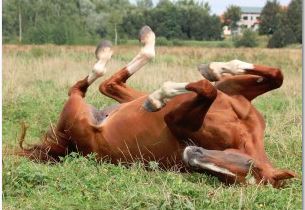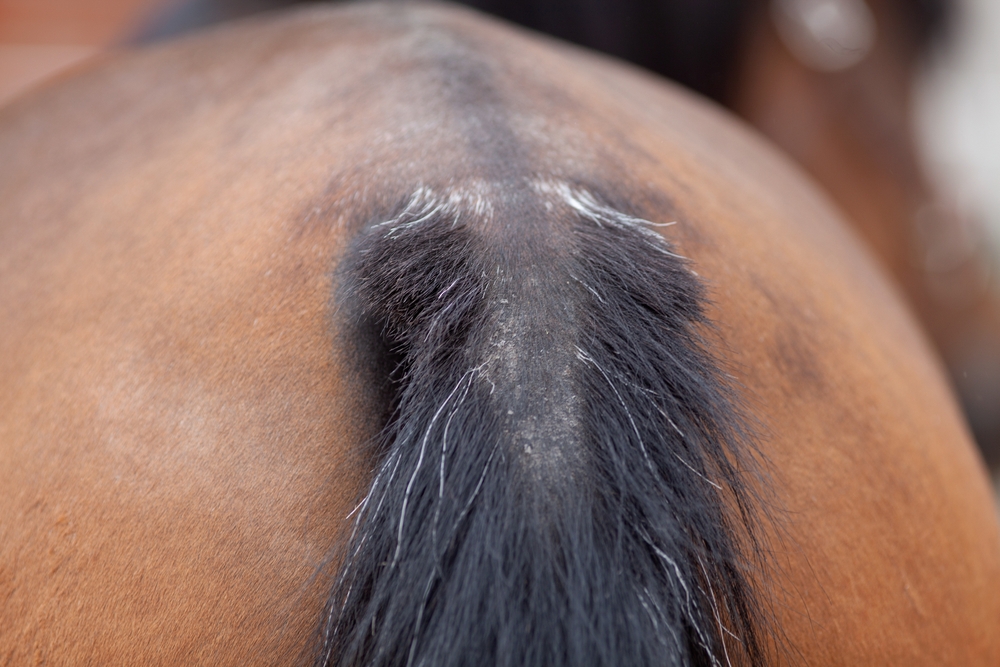
Animal Allergies
Whinny’s Wisdoms

Hey everybody, Whinny here! You know what really yanks my whiskers? Allergies! *Achew!*
All animals suffer from allergies. Now that we’re getting into the summer, we’ll all see allergies rear their ugly heads even more often. Just like you two-leggers get a summer “hay fever,” us critters have much higher exposure to pollen and bugs during the hot months of the year.
Overview
There are many types of allergies, but the broad categories are seasonal, food, and insect. Animals can be affected by some or all of these. This time of year, the main change for allergic animals will be bugs, so let’s talk about those first!
Insect Allergies
The types of insects we are mostly talking about that cause allergies are gnats for large animals and fleas for small animals. The way both of these work, at least in the sunny southeast, is that these bugs are all around us, and tend to bother all of us, but they bother some more than others because some animals are allergic to their gross bug saliva.
I commonly hear animal owners deny that their pets are affected by insects because they aren’t seeing a lot of them, or aren’t seeing more than a few on their unaffected animals. But the trouble with allergy to saliva is that it only takes one or two bug bites to create an allergic reaction, which comes from the immune system. When an animal’s body is exposed to an allergen, (bug saliva, in this case) little antibodies called IgE are produced. These call in reinforcements to create inflammation and bring about histamine.

Food Allergies
Food allergens tend to be more of an issue for smaller animals like dogs and cats. Our illustrious clinic cat Tony doesn’t have any food allergies (though he has chosen not to consume rodents like yours truly out of the kindness of his heart), but lots of dogs and cats have food allergies and sensitivities. The most common food allergies are to proteins like chicken or beef. The humans who make advertisements on the television love to make claims about grain allergies, but the truth is those are about as common as a cube of cheese in a barn that’s not a trap. It’s possible, but very unlikely.
Horses can definitely deal with inflammatory gastrointestinal conditions, but they don’t tend to stack up with skin symptoms to the same degree as dogs and cats. See? Being a horse isn’t all bad.
Seasonal Allergies
The growing seasons of spring and summer bring about pollen. You may not be able to see it easily, unless you park a dark vehicle under a tree, but my light brown fur tends to get highlighter yellow tips this time of year as I run through the fields around Springhill Equine. So I can confidently say the pollen is out in full force. There are options for specific seasonal allergy tests through a veterinary dermatologist. For this test, the dermatologist will put little bits of the allergens under the animal’s skin and watch for swelling to indicate reaction. Some companies advertise a blood test to diagnose seasonal allergies for all species, but unfortunately there is no evidence that these have any diagnostic value, so don’t waste your money.
Whinny Wisdom: Allergies are cumulative. An animal that is only mildly susceptible to both a bug allergy and a seasonal allergy will be more severely affected if they are exposed to both.
Diagnosing and Management
If you are worried about your animals having allergies, the correct first step is to have them evaluated by a veterinarian. Our doctors will do a complete physical exam, including taking a temperature. Sometimes, certain kinds of infections can look like allergies, so it’s always important to start with a physical exam. If the physical exam is otherwise normal, then there’s a conversation about the most likely type of allergy your pet has going on and a conversation about diagnostic tests. None of the tests are straightforward or cheap but most also involve an element of treatment.
For food allergies, we generally have a diet change. For dogs and cats this involves a prescription diet, whereas for horses or ruminants it is more about elimination diets, first starting with removing all hay or all grain, then working up from there. This category definitely marries both diagnosing and treating. We start with a different, hopefully novel, diet, and we keep that going for at least 6 weeks. This is where discipline is important. I struggle with that, as doing my daily 1000 tail curls can be tough, but discipline is super important here: your pet must not eat anything but the prescription or elimination diet that their doctor has recommended for the full time period. Then, if we see improvement, it’s time to have a conversation about whether to continue with that diet, or try to challenge them to really get confirmation.

For diagnosing allergies from those pesky invertebrates, the doctors almost always treat in order to diagnose. This usually means both topical and oral medications. For dogs and cats this always, always, always involves prescription strength flea prevention. Even if they are acting like their main problem is one of the other allergy types, we absolutely must control external parasites like fleas to control their level of itch.
For horses, the external parasites that cause allergies are typically things like gnats, so we use products with a repellant in them like citronella. Horses also tend to be much more focal in their response to parasite allergies, so we treat topically at the area of interest. I can’t tell you how many times I’ve seen big boxes of bottles of Equishield products come into inventory. I don’t get to explore the boxes when they come in (something about “paw germs” or something, ugh) but I do get to play in them when they make it out to the recycling bin, so I love it! Anyway, the topical Equishield products are used a lot because they do a GREAT job of combating insect allergies in horses. Dr. Speziok has even recommended them sometimes for certain farm dogs with seasonal allergies. When it works, it works.
Seasonal allergies are tough to definitively diagnose except by a dermatologist. Pragmatically, we often just manage this, especially because they only affect animals for part of the year. There is the option of intradermal skin testing, which will reveal specific allergens. If you choose to go this route, allergy vaccines can be developed which can potentially improve the allergies directly (the closest thing to a cure we have). But they are very hyperlocal, so you’ve gotta stay close to your den, err home, and not move!
Allergies in general are not curable, and often get worse over time. Allergies are unfortunately both time and money consuming. Managing them has to be a partnership between you, your veterinarian, and your pet (they have to cooperate and either get the baths and sprays, or take the pills and injections). Don’t let them get worse this year without treatment, get your critters in to see our doctors if you’re worried!
Until next week,
~Whinny
P.S. Are you watching the Horse Girl Goes to the Vet series on YouTube? It’s fantastic! Episode 13 just dropped this weekend. It’s only 90 seconds long, but it will make your day! Just click the blue text to check it out!
 Whinny’s Wisdoms is the official blog of Whinny the Clinic Mouse at Springhill Equine Veterinary Clinic in Newberry, Florida. If you liked this blog, please subscribe below, and share it with your friends on social media! For more information, please call us at (352) 472-1620, visit our website at SpringhillEquine.com, or follow us on Facebook!
Whinny’s Wisdoms is the official blog of Whinny the Clinic Mouse at Springhill Equine Veterinary Clinic in Newberry, Florida. If you liked this blog, please subscribe below, and share it with your friends on social media! For more information, please call us at (352) 472-1620, visit our website at SpringhillEquine.com, or follow us on Facebook!
[jetpack_subscription_form title="Subscribe to Whinny's Wisdoms"]

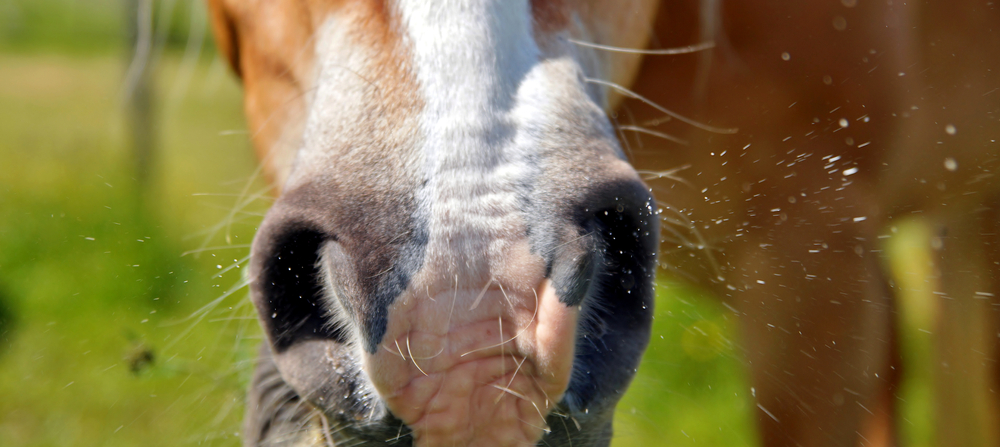
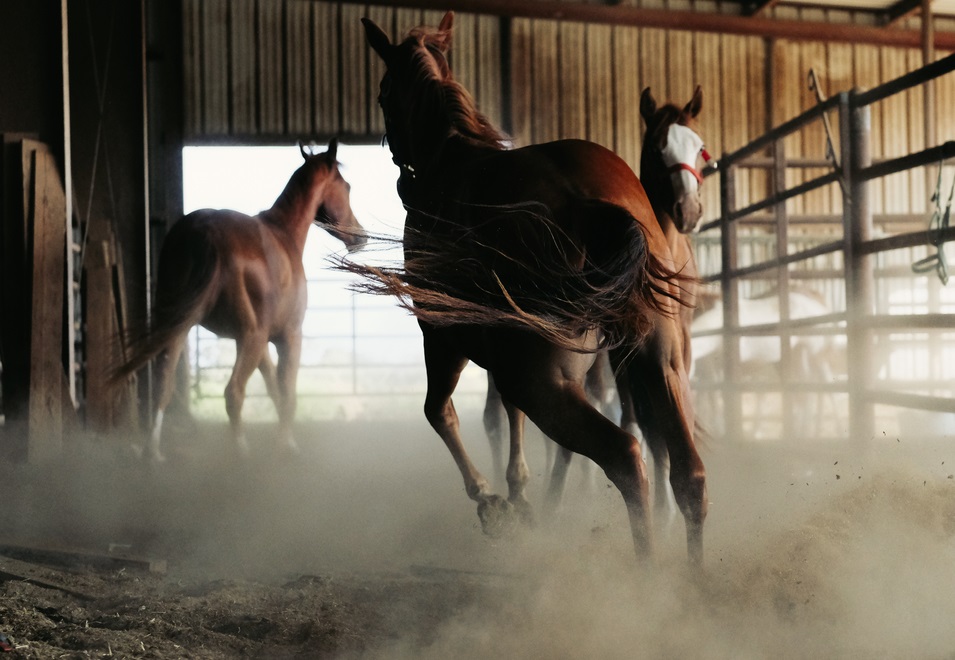

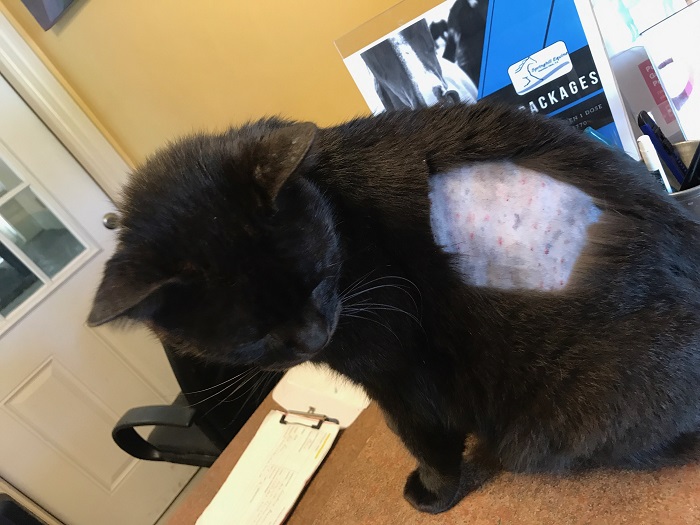
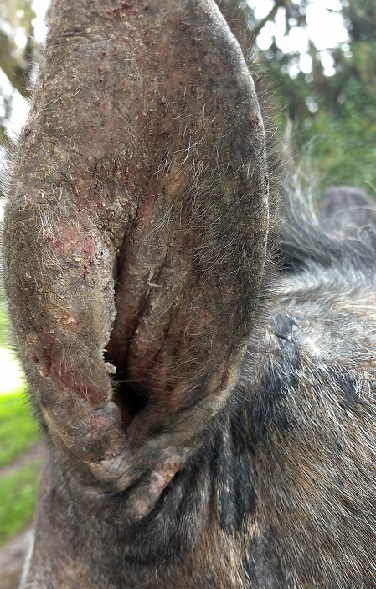
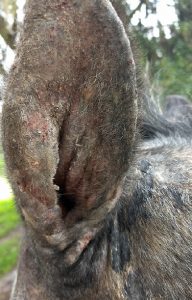 Culicoides (kyōō′lĭ-koi′dēz′) is a species of gnat very common here in Florida. Many horses are actually allergic to the saliva of this gnat, so every bite by one of these annoying little devils sends the poor horse into an itching frenzy. The early signs of this gnat allergy include frequent scratching and hair loss in the ears, mane, base of tail, and chest. Over time the skin in these places will become thickened, there will be multiple open bite wounds, the hair will be completely gone, and the horse will constantly be scratching on anything and everything he can find. Horses with chronic Culicoides hypersensitivity will often develop a “cauliflower ear” appearance over a period of years. Once this happens, the ears will never return to their original shape.
Culicoides (kyōō′lĭ-koi′dēz′) is a species of gnat very common here in Florida. Many horses are actually allergic to the saliva of this gnat, so every bite by one of these annoying little devils sends the poor horse into an itching frenzy. The early signs of this gnat allergy include frequent scratching and hair loss in the ears, mane, base of tail, and chest. Over time the skin in these places will become thickened, there will be multiple open bite wounds, the hair will be completely gone, and the horse will constantly be scratching on anything and everything he can find. Horses with chronic Culicoides hypersensitivity will often develop a “cauliflower ear” appearance over a period of years. Once this happens, the ears will never return to their original shape.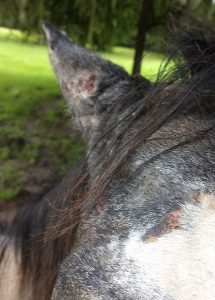 Once the ear has gotten to a point where there is a secondary laceration, abscess, or hematoma, it can be difficult to treat. While we always try conservative options first, these horses sometimes have to undergo surgery under general anesthesia to drain the ear, followed by weeks with the ear taped down against the horse’s head to allow for continued drainage. No fun.
Once the ear has gotten to a point where there is a secondary laceration, abscess, or hematoma, it can be difficult to treat. While we always try conservative options first, these horses sometimes have to undergo surgery under general anesthesia to drain the ear, followed by weeks with the ear taped down against the horse’s head to allow for continued drainage. No fun.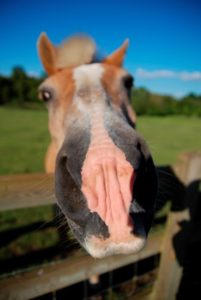
 You wouldn’t go outside all day in the middle of summer without any sunblock on, would you? Well, the same goes for your white horse, or even your chestnut horse with that little snip on his nose. If you are one of the lucky ones to own a mostly-white paint horse in Florida, you may want to invest in a full-body fly sheet with UV-blocking properties. But, if it’s just a strip or a blaze you need to cover up, daily application of sunblock or a fly mask may suffice. Don’t forget to protect your horse’s skin from sunburn just as you would your own!
You wouldn’t go outside all day in the middle of summer without any sunblock on, would you? Well, the same goes for your white horse, or even your chestnut horse with that little snip on his nose. If you are one of the lucky ones to own a mostly-white paint horse in Florida, you may want to invest in a full-body fly sheet with UV-blocking properties. But, if it’s just a strip or a blaze you need to cover up, daily application of sunblock or a fly mask may suffice. Don’t forget to protect your horse’s skin from sunburn just as you would your own!
